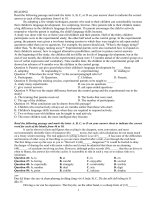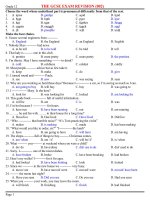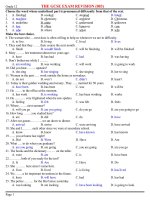GCSE 040
Bạn đang xem bản rút gọn của tài liệu. Xem và tải ngay bản đầy đủ của tài liệu tại đây (73.78 KB, 5 trang )
SƠ GD&ĐT VINH PHUC
TRƯƠNG THPT LIÊN SƠN
(Đề thi gồm: 05 trang)
ĐỀ KTCL ƠN THI THPT QUỐC GIA NĂM 20182019
Mơn: TIẾNG ANH – ĐỀ SỐ 040
Thời gian làm bài: 60 phút, không kể thời gian phát
đề
Ho va tên thi sinh:……………………………………………………………………. SBD:…………………………
Mark the letter A, B, C or D on your answer sheet to indicate the word that differs from the
other three in the position of primary stress in each of the following questions.
Question 01:
A. category
B. immature
C. engineer
D. addressee
Question 02:
A. arithmetic
B. television
C. interpreter
D. develop
Mark the letter A, B, C or D on your answer sheet to indicate the word whose underlined part
differs from the other three in pronunciation in each of the following questions.
Question 03:
A. machine
B. champagne
C. chute
D. chore
Question 04:
A. released
B. ceased
C. pleased
D. increased
Mark the letter A, B, C or D on your answer sheet to indicate the correct answer to each of the
following questions.
Question 05: Ann: “which is more important? Luck or effort?” Ben: “Luck is_________ effort.”
A. on the same importance
B. of the same importance as
C. the same importance as
D. as the same importance as
Question 06: Alan and Susie_________ an argument. They're not speaking to each other.
A. must have had
B. must have
C. might had
D. might have
Question 07: It is advised that not only Tam but also his friends_________ punctual.
A. be
B. are
C. is
D. were
Question 08: No matter how angry he was,he would never_________ to violence.
A. resolve
B. recourse
C. exert
D. resort
Question 09: When I finish writing this composition, I’m going to_________ and go to bed.
A. make time
B. hit the hay
C. hit the big time
D. call it a day
Question 10: _________ I’ve told him not to go out with those people, but he wouldn’t listen. Just let
him face the music now!
A. Many a time
B. Many the time
C. Quite a time
D. or a time
Question 11: Elderly people, _________, require constant attention.
A. a large number's depending on government aid
B. and many of them depend on the government to finance them
C. who are dependent many of them on the financing from the government
D. many of whom are financially dependent on the government
Question 12: She has to go on a_________ course in cooking because next month she’s getting
married.
A. crash
B. speedy
C. quickly
D. fast
Question 13: _________ not openly, I disagreed with him, as I didn't want to quarrel.
A. Since
B. Although
C. In spite of
D. Unless
Question 14: He_________ us the firm_________ wool since 1935.
A. told/ had been exporting
B. tells/ would export
C. said/ is exporting
D. will be told/ exports
Question 15: I was surprised to receive a_________ puppy for my birthday.
A. little cute eight-week-old golden retriever B. cute little eight-week-old golden retriever
C. cute eight-week-old little golden retriever D. eight-week-old cute little golden retriever
Question 16: It took the parents a long time to_________ their children’s games.
A. catch up with
B. catch up
C. catch on to
D. catch out
Question 17: “Are you ill? You look terrible!” “Well, I am a bit_________ The doctor says I must rest.”
A. run-down
B. run-off
C. run-out
D. run-up
Mark the letter A, B, C or D on your answer sheet to indicate the underlined part that needs
correction or the correct answer in each of the following questions.
Question 18: This evening it gives me a very great pleasure to welcome our new
friends from Australia.
A. gives me a
B. great
C. to welcome
D. from
Question 19: While the campaign, young volunteers helped build bridges, roads and
one hundred houses for disadvantaged families
A. while
B. build
C. hundred
D. disadvantaged
Question 20: The Olympic Games, first celebrated in Athens in 1896, were held every four years so
far, except during the two world wars
A. the
B. celebrated
C. were held
D. during
Mark the letter A, B, C or D on your answer sheet to indicate the most suitable response
complete each of the following exchanges.
Question 21: Barrack: "What do you think of a tie as a gift?" Linda: "______________"
A. No, it's not new.
B. No, it's too late.
C. No, it's too old.
D. No, it's too cheap.
Question 22: Ann: "New York must be the most interesting city in the world, don't you think?"
Mike: "___________"
A. No. I'd rather do something else.
B. Yes, I'd love to.
C. It might be. I don't know.
D. No, I don't like tall buildings.
Mark the letter A, B, C or D on your answer sheet to indicate the word(s) CLOSEST in meaning
to the underlined word(s) in each of the following questions.
Question 23: Teenage lethargy is often due to lack of proper nutrients.
A. sluggishness
B. enthusiasm
C. boredom
D. short-tempered
Question 24: Their arguments are getting pointless so they decided to just bury the hatchet and
forget what happened.
A. stop an argument and become friends again B. lose their tempers
C. fight tooth and nail
D. get into hot water
Mark the letter A, B, C or D on your answer sheet to indicate the word(s) OPPOSITE in
meaning to the underlined word(s) in each of the following questions.
Question 25: There has been no discernible improvement in the noise levels since lorries were
banned.
A. clear
B. obvious
C. thin
D. insignificant
Question 26: In some Western cultures, people who avoid eye contact in a conversation are
regarded as untrustworthy.
A. embarrassed
B. quiet
C. reliable
D. suspicious
Mark the letter A, B, C or D on your answer sheet to indicate the sentence that is closest in
meaning to each of the following questions.
Question 27 : In Nepal, literacy increased by approximately 40 percent from the early 1950s to the
end of the century.
A. 40 percent of the people of Nepal became literate during the latter half of the 20th
century.
B. At the end of the 20th century, about 40 percent of the Nepalese were literate, much
higher than in the early 1950s.
C. About 40 percent more of the Nepalese population became literate during the second half
of the 20th century.
D. From the middle to the end of 20th century, only about 40 percent of Nepalese people
could read and write.
Question 28: It is regretful that they destroyed the biggest Buddhist statue.
A. They wouldn't have destroyed the biggest Buddhist statue.
B. They shouldn't have destroyed the biggest Buddhist statue.
C. They couldn't have destroyed the biggest Buddhist statue.
D. They mustn't have destroyed the biggest Buddhist statue.
Mark the letter A, B, C or D on your answer sheet to indicate the sentence that best combines
each pair of sentences in the following questions.
Question 29: Henry tasted the pleasures of modern city life. Then he found life in his village hard and
unattractive.
A. Having tasted the pleasures of modern city life, Henry found life in his village hard and
unattractive.
B. After Henry found life in his village hard and unattractive, he tasted the pleasures of
modern city life.
C. If Henry had tasted the pleasures of modern city life, he would have found life in his
village hard and unattractive
D. Although Henry tasted the pleasures of modern city life, he found life in his village hard
and unattractive.
Question 30: "Yes, there's one left on the one that leaves in two hours."
A. Will you hold that reservation for me?
B. Why are you in such a rush to leave the country?
C. Are there any seats on the next flight to Paris?
D. Are you going to London for a holiday or on business?
Read the following passage and mark the letter A, B, C, or D on your answer sheet to indicate
the correct word or phrase that best fits each of the numbered blanks from 31 to 35.
The Rise of Electronic Media
As printed media begin to lose their dominance as a way to (31)_________ information to the
world, electronic media have stepped up and taken their place. Many people no longer read
newspapers or magazines in their traditional paper forms, but they still do read. The (32)___________
delivery system is what has happened; many people are reading newspapers or magazines off of
their smartphones, tablets, or on their computer screens.
Probably the greatest criticism of online newspapers and magazines is that there often isn’t
very much invested in the stories as they (33)__________. Rather than serious investigative
journalism, the main point of many online publications is merely to attract page views
(34)___________ the advertisers on those pages must pay a small fee. In the age of information,
finding the information (35)__________ learning becomes the hardest task of all.
Question 31:
A. show
B. convey
C. display
D. carry
Question 32:
A. exterior
B. natural
C. physical
D. mental
Question 33:
A. come out
B. publish
C. go out
D. turn out
Question 34:
A. although
B. so that
C. but
D. so
Question 35:
A. pointless
B. important
C. worthy
D. worth
Read the following passage and mark the letter A, B, C, or D on your answer sheet to indicate
the correct answer to each of the following questions.
Despite the fact that too much fat can be harmful, a moderate fat intake is actually essential
to the maintenance of good health. Some of the symptoms of fat deficiency include flaking skin,
emaciation, reduced functioning of the immune system, and fertility problems. Recent studies have
linked fat-free diets to increased stress and aggression, and note that those who try to eliminate
fat completely from their food intake may be at risk for developing eating disorders: a small
amount of fat in a meal will produce a feeling of satiety which lasts much longer than the sensation
of fullness produced by protein or carbohydrates. At least two teaspoons of fat per day is needed in
order for the digestive system to absorb vitamins A, D, E and K, which are fat soluble. These
vitamins are essential for healthy hair, skin, teeth, and eyes. Without the ability to absorb these
vitamins, children run the risk of developmental and neurological disorders. Adults need these
vitamins to manufacture fertility hormones.
Some types of fat actually help to reduce harmful cholesterol levels. Polyunsaturated fats
such as corn, soybean, and sesame oil, and monounsaturated fats like chicken fat and olive oil,
seem to lower blood cholesterol, while saturated fats – those found in red meat, dairy products,
and tropical oils – seem to raise the level of the kind of cholesterol that accumulates as plaques on
arterial walls. Paying attention to the type of fat consumed is just as important as reducing total fat
intake.
Question 36: What did the paragraph preceding this passage most likely discuss?
A. general health guidelines
B. methods of reducing one's percentage of dietary fat
C. moderate fat intake
D. health problems linked to fat consumption
Question 37: What is the author's main purpose in the passage?
A. To discuss some positive aspects of dietary fat.
B. To compare three kinds of cholesterol.
C. To prove that a low fat diet is inherently harmful.
D. To analyze recent studies linking fat intake to disease.
Question 38: All of the following are mentioned as signs of fat deficiency EXCEPT________.
A. flaky skin
B. fertility problems C. a feeling of satiety D. reduced immunity
Question 39: According to this passage, the most harmful type of fat would be found in________.
A. fish and vegetables
B. chicken fried in soybean oil
C. corn oil and olive oil
D. steak and cheese
Question 40: The word “note” in the passage is closest in meaning to________.
A. suggest
B. hope
C. notice
D. prove
Question 41: The word “those” in the passage is closest in meaning to________.
A. studies
B. diets
C. people
D. scientists
Question 42: The word “accumulates” in the passage is closest in meaning to________.
A. builds up
B. serves
C. creates
D. takes over
Read the following passage and mark the letter A, B, C, or D on your answer sheet to indicate
the correct answer to each of the following questions.
SO MUCH TO SAVE
The idea of preserving biological diversity gives most people a warm feeling inside. But
what, exactly, is diversity? And which kind is most worth preserving? It may be anathema to savethe-lot environmentalists who hate setting such priorities, but academics are starting to cook up
answers.
Andrew Solow, a mathematician at the Woods Hole Oceanographic Institution, and his
colleagues argue that in the eyes of conservation, all species should not be equal. Even more
controversially, they suggest that preserving the rarest is not always the best approach. Their
measure of diversity is the amount of evolutionary distance between species. They reckon that if
choices must be made, then the number of times that cousins are removed from one another
should be one of the criteria.
This makes sense from both a practical and an aesthetic point of view. Close relatives have
many genes in common. If those genes might be medically or agriculturally valuable, saving one is
nearly as good as saving both. And different forms are more interesting to admire and study than
lots of things that look the same. Dr Solow's group illustrates its thesis with an example. Six species
of crane are at some risk of extinction. Breeding in captivity might save them. But suppose there
were only enough money to protect three. Which ones should be picked?
The genetic distances between 14 species of cranes, including the six at risk, have already
been established using a technique known as DNA hybridization. The group estimated how likely it
was that each of these 14 species would become extinct in the next 50 years. Unendangered
species were assigned a 10% chance of meeting the Darwinian reaper-man; the most vulnerable, a
90% chance. Captive breeding was assumed to reduce an otherwise endangered species' risk to
the 10% level of the safest. Dr. Solow's computer permed all possible combinations of three from
six and came to the conclusion that protecting the Siberian, white-napped and black-necked cranes
gave the smallest likely loss of biological diversity over the next five decades. The other three had
close relatives in little need of protection. Even if they became extinct, most of their genes would be
saved.
Building on the work of this group, Martin Weitzman, of Harvard University, argues that
conservation policy needs to take account not only of some firm measure of the genetic
relationships of species to each other and their likelihood of survival, but also the costs of
preserving them. Where species are equally important in genetic terms, and - an important and
improbable precondition - where the protection of one species can be assured at the expense of
another, he argues for making safe species safer, rather than endangered species less endangered.
In practice, it is difficult to choose between species. Most of those at risk - especially plants,
the group most likely to yield useful medicines - are under threat because their habitats are in
trouble, not because they are being shot, or plucked, to extinction. Nor can conservationists choose
among the millions of species that theory predicts must exist, but that have not yet been classified
by the biologists assigned to that tedious task.
This is not necessarily cause for despair. At the moment, the usual way to save the genes in
these creatures is to find the bits of the world with the largest number of species and try to protect
them from the bulldozers. What economists require from biologists are more sophisticated ways to
estimate the diversity of groups of organisms that happen to live together, as well as those which
are related to each other. With clearer goals established, economic theory can then tell
environmentalists where to go.
[from The Economist]
Question 43: Dr. Solow believes that________
A. very rare species can't be saved
B. all very rare species should be saved
C. all species should be saved
D. only some species are worth saving
Question 44: Dr. Solow's work depended on________
A. the premise that all cranes should be protected B. previous biological research
C. the cost of preserving cranes
D. the premise that not all species are the same
Question 45: Three of the six species of endangered cranes________
A. were less interesting to admire than others
B. could be allowed to become extinct
C. were so rare they couldn't be saved
D. shouldn't be protected
Question 46: Dr. Weitzman believes that if two species are equally important genetically we should
protect________
A. the one that is more attractive
B. them both
C. the less endangered one
D. the rarer one
Question 47: Endangered species of cranes can be saved by________
A. stopping hunters from killing them
B. protecting their habitats
C. encouraging them to mate with their cousins D. keeping them in zoos or wildlife parks
Question 48: Most species are endangered because________
A. biologists haven't classified them
B. they are hunted or picked
C. we don't care enough about them
D. the places they live in are being destroyed
Question 49: Dr. Weitzman's ideas________
A. confirm Dr. Solow's
B. contradict Dr. Solow's
C. disregard Dr. Solow's
D. take Dr. Solow's ideas one step further
Question 50: According to the writer what has to be done first is for________
A. biologists to instruct economists
B. biologists to classiry undiscovered species
C. developers to stop destroying habitats D. economists to instruct biologists
_________THE END_________









